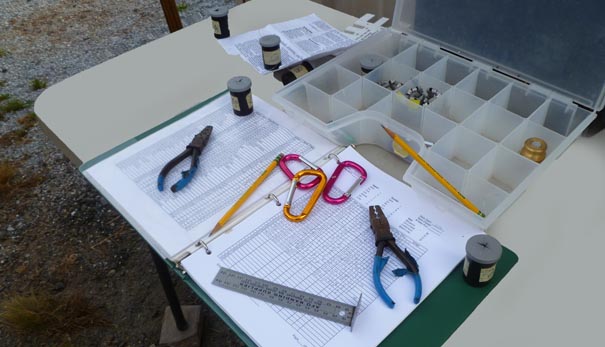Improvements to the Meadowlands District’s unique urban ecosystem are supported by the work of the Natural Resources Management Department. The Department’s surveys and studies on the region’s flora, fauna, and critical wetlands help guide enhancement and protection of the environment. These efforts include management of invasive plants such as common reed (Phragmites australis), mile-a-minute weed (Persicaria perfoliata), and tree-of-heaven (Ailanthus altissima). Department staff represents the Authority at interagency meetings on natural resources that address planning and regulatory issues.
The data gathered through such research furthers the NJSEA’s ongoing commitment to exploring ways to improve and protect vital natural resources in the region.
Current Natural Resources work includes a joint study with the Meadowlands Research and Restoration Institute (MRRI) examining changes in the diversity and density of benthic invertebrates –crustaceans, snails, worms, clams and other small creatures that inhabit the bottom of wetlands and waterways and provide food for fish as well as birds. The project, “Benthic Biodiversity and Benthic Pollutant Loads in Emergent Marshes of the NJ Meadowlands,” is funded by the U.S. Environmental Protection Agency and began in 2015. Samples collected are currently being compared to specimens gathered at the same locations during previous studies between 1999 and 2002. This study will equip the NJSEA with new knowledge about the ecological health of the Hackensack River system, its surrounding marshlands and the associated food web.

Another component of the research is to determine the concentration of contaminants in the sediments at wetland sites in the District, and the concentrations of contaminants in the benthic invertebrates living in those marshes. Data collected will provide information on the extent to which contaminants enter the ecological food web.
The USEPA funded another ongoing Natural Resources Management /MRRI project, “Measurement of Tidal Wetland Impairments for Acquisition and Enhancement in the New Jersey Meadowlands.”
Research was conducted at six sites in Lyndhurst, North Arlington and Secaucus. The examination of the diversity of plants, including invasive species, and a floristic quality assessment will give a better understanding of the habitat value and level of ecological functioning of these wetlands. As part of the study, scientists and naturalists assessed biological diversity, habitat fragmentation, tidal restrictions, proximity to landfills, and other factors that could prevent wetlands from functioning effectively. Vegetation surveys took place at these sites in 2014 and the locations were revisited in 2015 to clarify the identification of some plant species.

A Natural Resources Department study of the Diamondback Terrapin population involves collecting data on the species in the Meadowlands to help answer questions about the life history of terrapins in the region including population size, how far the turtles move within a marsh and their growth rate.
Diamondback Terrapins are of particular interest because they are an iconic animal of many coastal salt marshes and near the top of the food chain in the Meadowlands’ brackish marshes. Terrapins are relatively new to the District – they were first observed in the 1970s – and have experienced a recent rapid growth in population.
The turtle study includes collaboration with scientists and students from The Wetlands Institute in Stone Harbor, Hofstra University and Montclair State University.
Natural Resources staff also continues to analyze data from a multiyear inventory of fish and benthic invertebrates of the Hackensack River and major tributaries in the Meadowlands. A total of 210 fish collections and 312 benthic invertebrate collections were made in the most recent study.
The research compares the diversity of species of fish and benthic invertebrates and the number of specimens collected against inventories taken during 1987-1988 and 2001-2003. The 2001-2003 study showed a large increase in the abundance of certain species, including white perch, striped bass and bluefish, attesting to the improved water quality of the river.
The Department has conducted surveys of fiddler crab colonization of enhanced wetland sites as part of assessing the succession in development of the enhanced sites. Staff is now collaborating with the New Jersey City University, on a study comparing fiddler crabs on marshes here with colonies in southern New Jersey.

Natural Resources effort in performing observations on the number of different species of birds at determined stations in a specified timeframe has increased in recent years. Data is being collected at several sites for the first time to establish a baseline to allow for a future assessment of change over time. Some data from sites where point count surveys were performed in the past is showing greater diversity at sites following ecological enhancement.
The Department also conducts an annual project to promote Tree Swallow breeding populations at several wetland sites. Staff has installed approximately 300 nest boxes for swallows. Surveys of the success of these nests were conducted in 2008 and 2016. The nesting success was comparable to published results elsewhere in the country. Staff has also installed nest boxes for Wood Ducks, as well as bat houses.
Natural Resources assists and collaborates with multiple agencies and organizations. It represents the Authority on the US Army Corps of Engineers Interagency Review Team, which advises the Corps on wetland impact mitigation. The group has provided resources to the New Jersey Department of Environmental Protection in the development of a Wildlife Action Plan for the Meadowlands, assisted the State Department of Agriculture on biological control of invasive plants, and gives technical support to the Meadowlands Conservation Trust, a land preservation agency.
In addition, Natural Resources has participated in cooperative projects of common interest with non-governmental organizations including the New Jersey Audubon Society, New York City Audubon Society, Bergen County Audubon Society, Ducks Unlimited and the Wetlands Institute.